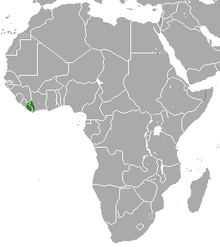Liberia mongoose
| Liberia mongoose | ||||||||||||
|---|---|---|---|---|---|---|---|---|---|---|---|---|
| Systematics | ||||||||||||
|
||||||||||||
| Scientific name of the genus | ||||||||||||
| Liberiictis | ||||||||||||
| Hayman , 1958 | ||||||||||||
| Scientific name of the species | ||||||||||||
| Liberiictis kuhni | ||||||||||||
| Hayman , 1958 |
The Liberian mongoose or Liberia kusimanse ( Liberiictis kuhni ) is a species of predator from the mongoose family that lives in West Africa . It was not scientifically described until 1958 and is considered to be threatened.
features
Liberia mongooses have a predominantly dark brown colored fur . A dark strip of fur flanked by two light strips stretches across the neck, the throat is light. The very dark feet are equipped with grave claws. The head is elongated, the muzzle pointed and flexible. The rounded ears are relatively small. The tooth formula is I 3/3 - C 1/1 - P 4/4 - M 2/2, so a total of 40 teeth. The teeth are small and the jaws are relatively weak. These animals reach a head body length of 43 to 47 centimeters and a tail length of around 20 centimeters, the weight is around 2.3 kilograms. There is no sexual dimorphism known, the sexes are so equal.
distribution and habitat
Liberian mongooses have a very small range. They are only known from northeastern Liberia and from neighboring areas of the Ivory Coast . Presumably they also live in southern Guinea . Their habitat are densely vegetated forests, mostly near rivers.
Way of life
Liberia mongooses are diurnal and mostly stay on the ground. At night they sleep in hollow logs, under fallen trees and occasionally in termite mounds. The same sleeping place is rarely used twice in a row. They live in groups of four to six animals, but larger groups have also been reported. Adult males, however, often live alone; a male monitored with a radio collar regularly switched between three stable groups and stayed there for one to three days. They are very quiet and only communicate with grunts. Occasionally they hang out near soot reports and respond to their alarm cries.
With their grave claws and pointed snout, these mongooses are well adapted to foraging in the ground. Their diet consists mainly of large worms from the Megascolecidae family . They also eat burrows and possibly other vertebrates as well as insect larvae and fruits.
Little is known about reproduction. The births probably fall in the rainy season between May and September, when the food supply is greatest.
threat
Western science only became aware of this species in 1958, and it was not until 1989 that the first living specimens were sighted. Their threats include habitat destruction from agriculture and mining, and hunting for their meat. Also pesticides are dangerous because they accumulate in their prey and poison the animals that way. The International Union for Conservation of Nature ( IUCN) estimates that the total population has decreased by more than 30% in the last 15 years, it fears a further decrease and lists the species as "endangered" ( vulnerable ).
literature
- Ronald M. Nowak: Walker's Mammals of the World . Johns Hopkins University Press, 1999 ISBN 0-8018-5789-9
- JS Gilchrist, AP Jennings, G. Veron and P. Cavallini: Family Herpestidae (Mongooses). In: Don E. Wilson, Russell A. Mittermeier (eds.): Handbook of the Mammals of the World. Volume 1: Carnivores. Lynx Edicions, 2009, ISBN 978-84-96553-49-1 , pp. 262-329.
Web links
- Liberiictis kuhni in the endangered Red List species the IUCN 2009. Posted by: Dunham, A. & Gaubert, P., 2008. Accessed January 26 of 2010.
- Information and photo on arkive.org
